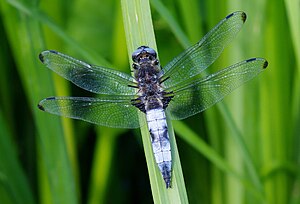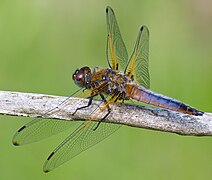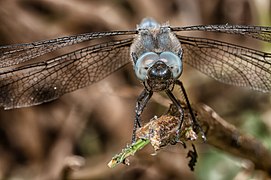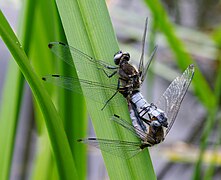Tip spot
| Tip spot | ||||||||||||
|---|---|---|---|---|---|---|---|---|---|---|---|---|

Tip spot ( Libellula fulva ), mature male, |
||||||||||||
| Systematics | ||||||||||||
|
||||||||||||
| Scientific name | ||||||||||||
| Libellula fulva | ||||||||||||
| OV Müller , 1764 |
The tip spot ( Libellula fulva ) is a dragonfly species from the family of the sail dragonflies (Libellulidae) and thus belongs to the large dragonflies (Anisoptera). The tip spot is a medium-sized dragonfly with a predominantly Central European distribution area. In the Red List of Threatened Animal Species for Germany, the species was classified as critically endangered in 1998, in the list for Germany and Switzerland from 2015 as not endangered, and in Austria as endangered.
features
The tip spot reaches wingspans of 7.5 to 8 centimeters and is one of the medium-sized dragonflies in Central Europe. It is named after the colored wing end (apex) of the females, which, however, is sometimes less evident in the males. At the base of the hind wings of both sexes there is a triangular, black-brown basal spot.
Like the flat belly ( Libellula depressa ), the tip spot shows a sexual dimorphism in terms of body color. Young females have a bright orange body, the abdomen ( abdominal ) dorsal black, to the chest ( thorax itself has tapered triangles) out. With increasing age, the body color changes to a darker brown-orange with comparable, but slightly more pronounced triangles on top of the abdomen. In contrast to the female, the colored male has a clearly blue frosted abdomen with an otherwise brown body color. The last three segments of the abdomen are black-brown in color. Juvenile males, however, still resemble the brown-orange females.
Similar species
The tip spot differs from the flat belly in the absence of dark brown spots at the base of the forewings, i.e. at the attachment point of the first pair of wings on the thorax. The large blue arrow ( Orthetrum cancellatum ), on the other hand, lacks any drawing on the base of both pairs of wings.
Compared to the quadrangle ( Libellula quadrimaculata ), the tip spot lacks the second color mark on the upper edge in the middle of the wings (postnodal).
Way of life
The top spot is active in the months May to June (flight time) and can be found mainly in stagnant and slowly flowing waters with reed stands on the banks, whereby the waters should be rich in vegetation and sunlit.
On sunny mornings, the first to be found are the males who, as hunters from the hide, seek out sitting areas with an unobstructed view of the water and also defend their territory against their own or foreign rivals. In contrast to the males, the females do not appear until noon, so that matings can only be observed at late noon.
Mating and development
The mating of the tip spots is initiated in flight and is terminated in the nearby vegetation. The females cling to the males' abdomen and use their legs to smudge the bluish wax coating in the middle of the abdomen (compare photos of the mature - blue - males).
After the female has laid eggs in flight over the water, the larvae of the top spot hatch after about two to six weeks. After several stages in the water, the larvae need about two years to complete their development into an imago .
In the water, dragonfly larvae are predators and, as the most effective organ for their predatory way of life, have the typical trap mask , which is retracted under the head when at rest. If the prey is appropriate, the catching mask snaps out to take hold of it. The larvae of the dragonflies usually feed on other insect larvae, but also on small vertebrates such as z. B. Tadpoles.
photos
literature
- Heiko Bellmann: Observe dragonflies - determine , Naturbuch Verlag, Augsburg 1993. ISBN 3894401079
- Sternberg, K., B. Höppner & R. Buchwald: Libellula fulva Müller, 1764 - top spot. Pp. 448-458. In: Sternberg, K. & R. Buchwald (eds.): Die Libellen Baden-Württemberg. Volume 2: Dragonflies (Anisoptera). Ulmer, Stuttgart 2000, ISBN 3-8001-3514-0
- Gerhard Jurzitza: The Kosmos dragonfly guide , Franckh Kosmos Verlag GmbH & Co., Stuttgart 2000. ISBN 3440084027
Web links
Individual evidence
- ↑ Red Lists of Endangered Dragonflies in Germany. Retrieved June 7, 2018 .
- ↑ LibellenWissen.de. Retrieved June 7, 2018 .





